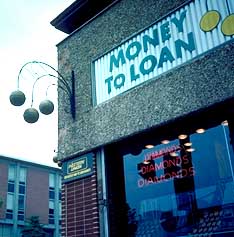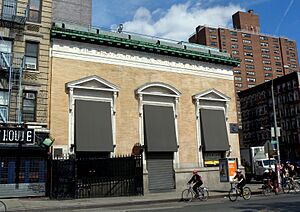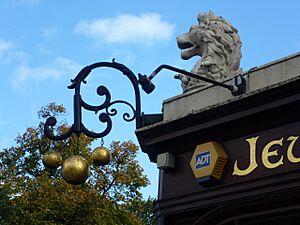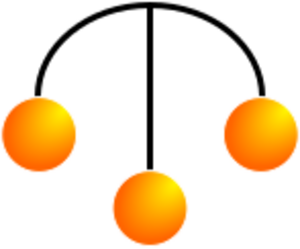Pawnbroker facts for kids

A pawnshop (also called a pawn shop or pawnbroker) is a shop or business who loans money to people who bring in valuable items which they leave with the pawnbroker. Examples of items that a person may leave are jewelry, gold, watches, cameras, musical instruments, televisions or gadgets like computers, smart phones or tablets.
The valuables that people leave are called the "collateral". The person can get their valuable item back from the pawnbroker if they pay back the money they were loaned and pay interest on the loan. Interest is like a fee for getting to use someone else's money for a set time period. If the person who has borrowed money from the pawnbroker does not repay the loan and interest within an agreed-upon time limit, the pawnbroker can sell the valuable item to another customer to get back the money they loaned.
To prevent thieves from using pawnshops as a way to get money from stolen goods, many communities have laws requiring that people who bring in valuable items to the pawnshop have to show identification, such as a driver's licence.
History

The first pawn shops were in ancient China about 3,000 years ago. Pawnbrokers, often working independently, would offer short-term credit to peasants. The business model existed 1,500 years ago in Buddhist monasteries, no different from today, through the ages strictly regulated by Imperial or other authorities.
In the West, pawnbroking existed in the ancient Greek and Roman civilizations. Most contemporary Western law on the subject is derived from the Roman jurisprudence. As the empire spread its culture, pawnbroking went with it.
In spite of early Roman Catholic Church prohibitions against charging interest on loans, there is some evidence that the Franciscans were permitted to begin the practice as an aid to the poor. In 1338, Edward III pawned his jewels to raise money for his war with France. King Henry V did much the same in 1415. In 1603 an Act against Brokers was passed and remained on the statute-book until 1872. It was aimed at the many counterfeit brokers in London. This type of broker was evidently regarded as a fence.
Crusaders, predominantly in France, brokered their land holdings to monasteries and diocese for funds to supply, outfit, and transport their armies to the Holy Land. Instead of outright repayment, the Church reaped a certain amount of crop returns for a certain amount of seasons, which could additionally be re-exchanged in a type of equity.
A pawnbroker can also be a charity. In 1450, Barnaba Manassei, a Franciscan friar, began the Monte di Pietà movement in Perugia, Italy. It provided financial assistance in the form of no-interest loans secured with pawned items. Instead of interest, the Monte di Pietà urged borrowers to make donations to the Church. It spread through Italy, then to other parts of Europe. The first Monte de Piedad organization in Spain was founded in Madrid, and from there the idea was transferred to New Spain by Pedro Romero de Terreros, the Count of Santa Maria de Regla and Knight of Calatrava. The Nacional Monte de Piedad is a charitable institution and pawn shop whose main office is located just off the Zócalo, or main plaza of Mexico City. It was established between 1774 and 1777 by Pedro Romero de Terreros as part of a movement to provide interest-free or low-interest loans to the poor. It was recognized as a national charity in 1927 by the Mexican government. Today it is a fast-growing institution with over 152 branches all over Mexico and with plans to open a branch in every Mexican city.
Three-ball symbol

The pawnbrokers' symbol is three golden balls suspended from a bar. The three-ball symbol may be indirectly attributed to the Medici family of Florence, Italy, owing to its symbolic meaning in heraldry. This refers to the Italian region of Lombardy, where pawn shop banking originated under the name of Lombard banking. It has been conjectured that the golden balls were originally three flat yellow effigies of bezants, or gold coins, laid heraldically upon a sable field, but that they were converted into balls to better attract attention.
Most European towns called the pawn shop the "Lombard". The Lombards were a banking community in medieval London, England. According to legend, a Medici employed by Charlemagne slew a giant using three bags of rocks. The three-ball symbol became the family crest. Since the Medicis were so successful in the financial, banking, and moneylending industries, other families also adopted the symbol. Throughout the Middle Ages, coats of arms bore three balls, orbs, plates, discs, coins and more as symbols of monetary success.
Saint Nicholas is the patron saint of pawnbrokers. The symbol has also been attributed to the story of Nicholas giving a poor man's three daughters each a bag of gold so they could get married.



